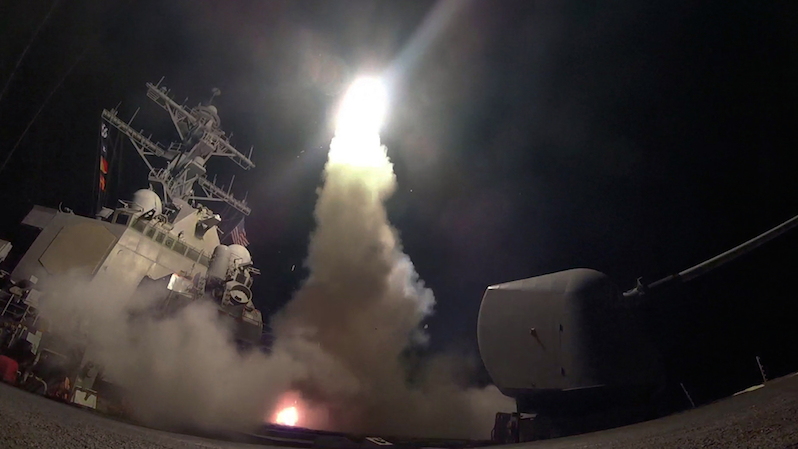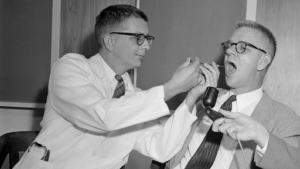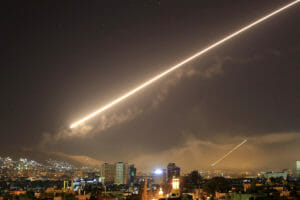Dereliction of Duty, Redux
All the evidence in Syria leads to an inescapable conclusion: The American military strike was a violation of international law. The guided-missile destroyer USS Porter launches a Tomahawk land attack missile aimed at Shayrat air base in Syria on April 6. (Mass Communication Specialist 3rd Class Ford Williams / U.S. Navy via AP)
1
2
3
4
The guided-missile destroyer USS Porter launches a Tomahawk land attack missile aimed at Shayrat air base in Syria on April 6. (Mass Communication Specialist 3rd Class Ford Williams / U.S. Navy via AP)
1
2
3
4
As presented to the public, the intelligence McMaster cited is woefully inadequate for making a case that Syria used chemical weapons against Khan Shaykhun. Indeed, the evidence seems to corroborate Syrian and Russian claims that the SU-22 aircraft used against Khan Shaykhun employed conventional weapons, and not the chemical weapons the rebels claimed.
The critical evidence is the IR signatures detected by the U.S. and linked to weapons release over Khan Shaykhun, and to weapons impact on the ground. Rebel sources make specific reference to four “rockets” being fired by the Syrian aircraft. These same sources speak of three explosions, and one “dud-like” noise indicative of a warhead failing to detonate. Video provided by the rebels shows four distinct weapons impacts for these munitions in Khan Shaykhun—three showing signatures associated with high explosive events and one consistent with white smoke.
The use of rockets by the Syrian SU-22 is consistent with the IR sensor readouts relied upon by the U.S.—only the ignition of a rocket motor would provide the kind of weapons-release signature the U.S. claims it observed. There would be zero IR signature associated with the release of a gravity bomb, whether or not it carried a high explosive or chemical warhead. Moreover, a chemical warhead, by design, would not produce an IR signature upon impact. The weapon would either fracture on impact, spreading the agent contained through inertia, or use a small burster charge inside the weapon to split the casing and disperse the agent above ground for maximum effect. In short, it is physically impossible for a chemical weapon to produce the impact IR signatures detected by the U.S. and linked to the Khan Shaykhun attack.
The Syrians have a history of employing air-to-ground rockets against rebel targets from their SU-22 aircraft. Photographs and images from Shayrat clearly show the presence of smaller S-8 rockets, with 3.9 kilogram high explosive warheads, and larger S-24 rockets, with 123 kilogram high explosive warheads. The S-8 rocket also uses a smoke warhead for target designation purposes. The IR data collected by the U.S., when combined with the rebel eyewitness statements and video, provides unequivocal corroboration of the Syrian government’s claim that it employed conventional weapons against Khan Shaykhun.
The video evidence of high-order detonation by at least three of the rocket impacts is proof positive of a high-explosive payload. The white smoke observed in the third impact event is consistent with what one would see from a smoke warhead used to designate the target for attack, a common air-to-ground tactic familiar to any pilot who has used unguided munitions in combat. (I qualified as an aerial observer in U.S. Marine Corps OV-10 and A-4 aircraft, and employed these very tactics when marking targets for aircraft dropping conventional gravity bombs.)
The high velocity associated with these rockets—more than 600 meters per second—and their small warhead size makes them ill-suited for chemical weapons deployment. There is no evidence that either the S-8 or S-24 rockets have ever been fitted with a chemical warhead. For the U.S. case to hold any water, Syria would have had to undertake a covert weapons development program that designed, developed and produced a new class of chemical warhead possessing zero military value (the small amount of agent able to be carried, combined with the high impact speeds, makes no military sense).
In addition, the images and first-person narrative relied on by the U.S. to sustain its conclusion that sarin was used against Khan Shaykhun directly contradicts the conclusion reached. Victims speak of a “yellow-blue” smoke, and a pungent odor. Sarin is a colorless, odorless liquid. Furthermore, the handling of victims by rescuers, dramatically captured on video by the “White Helmets,” shows personnel without any protective equipment interacting with contaminated individuals. Again, I have received specialized, live-agent training at the U.S. Army facility at Fort McClellan, Ala., where hazardous materials technicians are trained to rescue persons exposed to sarin nerve agent. Any rescuer who handled contaminated persons in the manner shown on the “White Helmet” video would themselves become victims. In other words, the video images relied upon by the Trump administration is actually contraindicative of the presence of sarin nerve agent at Khan Shaykhun.
Any intelligence analyst worthy of the title, drawing on the information cited by McMaster, would have reached similar conclusions—that conventional, high-explosive, air-to-ground rockets were used by the Syrian SU-22 aircraft against Khan Shaykhun, and that there was a low probability that sarin was used on victims from the town. (It should be noted that the images of victims were taken at the “White Helmets” base, after they had been transported there, and not from the alleged site of the chemical attack.)
There is no disputing that a chemical event occurred that resulted in victims, many of them children, being treated at the “White Helmets” base. The evidence used by the U.S. to underpin its assertion that the deaths and injuries were the result of a chemical weapon containing sarin nerve agent employed by a Syrian SU-22 originating from Shayrat, however, does not sustain this allegation. It directly contradicts it.
Russia and Syria have claimed that the Syrian air strike, ostensibly against a weapons storage facility, caused chemical agents in possession of the rebels to leak, and that it was these agents that caused the casualties in Khan Shaykhun. Russia has provided the OPCW with evidence that rebels affiliated with Tahrir al-Sham had operated a chemical weapons manufacturing facility in Eastern Aleppo that produced a chlorine-white phosphorus agent that was used to fill mortar rounds and land mines. To date, the OPCW has not provided an evaluation of this evidence. When Tahrir al-Sham evacuated Eastern Aleppo in late 2016, many of its fighters, including those who had been involved in the chemical weapons manufacturing facility uncovered by the Russians, moved to Idlib province, where Khan Shaykhun is located.
While the jury is out on the existence of a rebel cache of chemical weapons in Khan Shaykhun, and whether or not it killed and injured the civilian victims (many of whom exhibited symptoms of chlorine exposure), one thing is clear: With the allegation of Syrian government involvement disproved by the evidence cited by McMaster, the Russian claims remain the only viable possibility, and as such should be worthy of the kind of international investigation being called for by Russia and Syria, but opposed by the United States.
According to McMaster and Mattis, both of whom spoke to the media on April 6—explaining the deliberative processes associated with the decision-making behind the strike—there was little, if any, questioning of the intelligence information used to justify military action. Instead, it appears the question of assigning guilt was resolved early on, and the bulk of the meetings that transpired focused on assessing military options, and squaring these options with U.S. policy objectives in Syria.
McMaster describes three briefing interactions with Trump. The first consisted of an initial briefing about what had transpired in Khan Shaykhun, which drew on the aforementioned U.S. radar and IR data and the “White Helmets” victim video and imagery. The next meeting involved a full gathering of the National Security Council, where military options were discussed. McMaster describes the interaction between the president and the NSC as helping the president understand “the degree of agency and control we have over this very complex situation.” The president reportedly asked questions, and then the NSC withdrew to refine their options, before presenting the final option—a targeted strike against Shayrat—which Trump approved.
Even more important than the decision to strike and the nature of that strike (given the limited nature of the military action) was its objective—why the U.S. would engage in unilateral military aggression against a U.N. member state. According to McMaster, the objective was “to deter the continued use” of chemical weapons by the Syrian government against a civilian populace by sending a “very strong signal to Assad and his sponsors (i.e., Russia and Iran) that the United States cannot stand by as he [Assad] is murdering innocent civilians.”
The choice of Shayrat air base was driven by the need for the U.S. to respond to the “source of this particular attack” in order to “send a strong message.” Military planners picked out a number of targets that, according to McMaster, “were associated with the ability of that airfield to operate and continue mass murder attacks against … Syrian civilians.” There was some constraint shown, namely in minimizing risk to any Russian military personnel and equipment stationed at Shayrat (a Russian special forces unit, together with an attack helicopter unit, were operating out of the base at the time of the attack).
Your support matters…
SUPPORT TRUTHDIG
Independent journalism is under threat and overshadowed by heavily funded mainstream media.
You can help level the playing field. Become a member.
Your tax-deductible contribution keeps us digging beneath the headlines to give you thought-provoking, investigative reporting and analysis that unearths what's really happening- without compromise.
Give today to support our courageous, independent journalists.





You need to be a supporter to comment.
There are currently no responses to this article.
Be the first to respond.